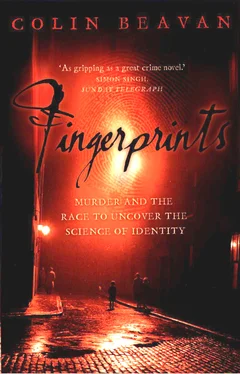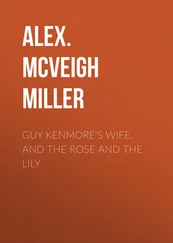Finally, in 1863, when the non-payment of rent had reached crisis point and land and lease litigation choked the courts, Herschel penned an official letter to his superiors suggesting his system for prevention of lease forgery. The first two fingers of both the landlord and the tenant should be impressed on each lease, he wrote, so that neither could alter it or disavow it in the future. Government higher-ups rejected Herschel’s idea, feeling that it might cause ill feeling just at the time when the indigo disturbances were quieting down. Herschel bided his time.
Fourteen years passed before a more senior Herschel, now magistrate of Hooghly, near Calcutta, was finally able to institute fingerprinting under his own authority. He introduced the system in three separate departments. For a year-long period, between 1877 to 1878, government pensioners in his region signed for their monthly payments with fingerprints. At the registry of deeds, land owners impressed fingerprints to authenticate their transactions. At the courthouse, convicts were forced to fingerprint their jail warrants so hired substitutes could not take their place at the prison. One year before he retired and moved back to England, nearly twenty years after he first came up with the idea, Herschel had finally put fingerprints to official use.
Herschel had, with a little help from the Chinese, conceived the use of fingerprints to irrefutably identify documents with their signatories. But he did not realize until much later, when it was pointed out to him, that fingerprints could be used to identify unknown criminals. Nor had he developed the fingerprint concept sufficiently to be used for that purpose.
Nowhere in his writings, for example, did Herschel mention any large-scale experiments to determine for certain that no two fingerprints were alike. Nor did he discuss what features of two fingerprints should be compared to determine if they had come from the same or different fingers. In fact, the fingerprints in the record books from the Hooghly Registry of Deeds, made in runny, water-based ink, were so faint and smeared that they were often indistinguishable. Even if Herschel understood the technical nuances of fingerprinting, it is clear that his subordinates did not. Under Herschel, fingerprints were more effectively used as a means of intimidation than for any real scientific purpose.
In his 1917 memoir, Herschel would nevertheless claim sole credit for conceiving the fingerprint method of criminal identification, even denying the contributions of the Chinese. As supposed documentary evidence, he produced what was to be known as the “Hooghly Letter,” written by him in August 1877 to Bengal’s Inspector of Jails and Registrar-General. In it, he suggested the widespread expansion of the two-digit fingerprint signatures he used in Hooghly to jailers’ warrants and deed registries throughout Bengal. His suggestion was rejected. More importantly, his letter suggested neither the use of fingerprints to identify unknown criminals in police custody nor their use as crime-scene evidence. Herschel’s letter did not suggest the fingerprint system as it is used today.
In 1878, when Herschel returned to England permanently, his successor in Hooghly did not see the value in Herschel’s fingerprint registration, and discontinued it. After only one year, Herschel’s system fell into disuse. It had not proved itself to anyone but Herschel himself. So, though it was already being quietly investigated by the obscure Scottish medical missionary Henry Faulds in Japan, fingerprinting again fell temporarily into obscurity. This time it did so right when jailers, police, and criminologists needed a system of identification more than ever before.
“… Lawrence Earl Ferrers, Viscount Tamworth, shall be hanged by the neck until he is dead and … his body will be dissected and anatomized,” said a writ of execution read out in the House of Lords in May 1760. When Earl Ferrers’s wife left him because of his bouts of drunken violence, a man named Johnson got the job of collecting her maintenance payments. The earl grew to hate Johnson and his monthly visits, and eventually shot him dead. It was for this that Ferrers was tried and condemned by the House of Lords.
At the appointed hour, the noose descended over the earl’s head, the gallows trap door swung open under his feet, and he fell until the rope jerked him to a sudden stop. His neck broke with a sickening crack. After his body hung limp and lifeless for the customary hour, undertakers carted it to Surgeon’s Hall in the City of London for dissection. Surgeons slit open the abdomen and removed his bowels. They sliced two strips of flesh from his chest and drew them open like curtains to reveal his bloody organs. His eviscerated body, then displayed in a public gallery as a warning against would-be murderers, became a cheap, gory sideshow for the public to parade past. Earl Ferrers’s memory suffered its final insult.
The gutting, a fate reserved especially for murderers in eighteenth-century Britain, numbered just one among the many ruthless provisions of the period’s criminal law, known as the “Bloody Code.” For over 200 different crimes, the Code prescribed death as easily as today’s law might call for community service. Begging, if you were a soldier or sailor, could earn you a stretch of the neck, and so could spending more than a month with gypsies. Between 1805 and 1818, a fifth of those who mounted the gallows’ steps under the Code had done nothing worse than forge bank notes.
Continental society was just as cruel to its criminals. Three years before Earl Ferrers’s gutting, France sentenced Robert-François Damiens to be burned and cut to pieces for trying to stab Louis XV. Each time red-hot pincers tore off a piece of Damiens’s flesh and opened a new wound, molten lead was poured in to stanch the flow of blood. Letting Damiens bleed to death would be far too kind. “My God, have pity on me. Jesus, help me!” Damiens moaned. When the executioner finally tethered six strong horses to Damiens’s arms and legs, his body proved too strong to be pulled apart. Only after his tendons were cut did Damiens’s limbs tear from their sockets.
Not all eighteenth-century criminals suffered such endless torture. In lower-profile cases, judges sometimes broke from the law and showed mercy. But this discretionary sentencing turned the judicial process into a sort of high-stakes crap shoot. For the same crime, depending on the judge, one lucky outlaw might be exiled to America, while another might be tortured or killed. This uneven application of the law undermined its moral authority. It was for this reason, not because of compassion for the condemned, that Europe’s great legal thinkers finally called for change.
In 1764, the Milanese statesman Cesare Beccaria published Dei deletti e delle pene (Crimes and Punishment) a seminal book on criminology. It sparked a hundred years’ worth of legal reforms, leading, eventually, to a system that could not operate without an infallible method of identification, such as fingerprinting. A twenty-six-year-old aristocrat, trained in law at the University of Pavia, Beccaria argued that, because of piecemeal development over several centuries, criminal law was an irrational mishmash. Prescribed punishments bore no relation to the seriousness of their crimes. “Whomsoever sees the same death penalty, for instance, decreed for the killing of a pheasant and for the assassination of a man … will make no distinction between the crimes,” Beccaria wrote.
Criminal law needed a massive overhaul. Beccaria called for standardized punishments that were only severe enough to make would-be criminals think twice. The certainty of a punishment, not its severity, had the greatest deterrent effect, he said. A burglar, positive of being caught and sent to jail, even for a short time, was less likely to commit a robbery than one who, if caught, might be executed.
Читать дальше












